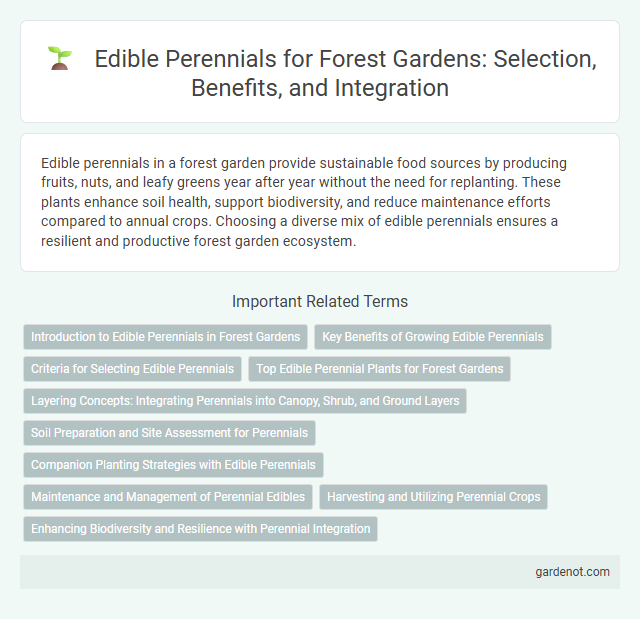Edible perennials in a forest garden provide sustainable food sources by producing fruits, nuts, and leafy greens year after year without the need for replanting. These plants enhance soil health, support biodiversity, and reduce maintenance efforts compared to annual crops. Choosing a diverse mix of edible perennials ensures a resilient and productive forest garden ecosystem.
Introduction to Edible Perennials in Forest Gardens
Edible perennials are essential components of forest gardens, providing sustainable and nutritious food sources year after year without the need for replanting. These plants, such as berry bushes, nut trees, and herbaceous perennials, establish deep root systems that improve soil health and resilience against erosion. Integrating diverse edible perennials enhances biodiversity, supports pollinators, and creates a low-maintenance ecosystem that mimics natural forests.
Key Benefits of Growing Edible Perennials
Edible perennials in forest gardens provide sustainable food sources with minimal maintenance, producing bountiful harvests year after year. Their deep root systems improve soil health by preventing erosion and enhancing nutrient cycling. Growing these plants reduces the need for replanting, conserves water, and supports biodiversity through habitat creation.
Criteria for Selecting Edible Perennials
Selecting edible perennials for a forest garden involves evaluating factors such as climate adaptability, soil compatibility, and growth habit to ensure sustainable yields. Prioritizing species with high nutritional value, resistance to pests and diseases, and low maintenance needs supports ecological balance and productivity. Important criteria also include seasonal availability and the plant's role in supporting pollinators and enhancing biodiversity within the forest garden ecosystem.
Top Edible Perennial Plants for Forest Gardens
Top edible perennial plants for forest gardens include varieties such as pawpaw (Asimina triloba), which produces nutritious tropical-flavored fruit and thrives in understory conditions. Other prime choices are hardy kiwi (Actinidia arguta) and serviceberry (Amelanchier spp.), both offering high yields of vitamin-rich berries while enhancing biodiversity. Incorporating perennial herbs like sorrel (Rumex acetosa) and lovage (Levisticum officinale) provides continuous harvests of flavorful greens, increasing year-round productivity and soil health.
Layering Concepts: Integrating Perennials into Canopy, Shrub, and Ground Layers
Edible perennials play a crucial role in forest garden layering by integrating into canopy, shrub, and ground layers to maximize space and productivity. Canopy layers include fruit and nut trees like chestnuts and elderberries, while shrubs such as currants and gooseberries fill mid-level spaces, providing diverse yields. Ground layers feature low-growing perennials like rhubarb and wild garlic, enhancing soil health and creating a resilient, multi-layered edible ecosystem.
Soil Preparation and Site Assessment for Perennials
Soil preparation for edible perennials in a forest garden involves deep loosening of soil to improve aeration and root penetration, combined with the incorporation of organic matter such as compost or aged manure to enhance fertility and moisture retention. Site assessment should consider factors like sunlight exposure, soil pH between 6.0 and 7.5, drainage, and proximity to water sources to ensure optimal growing conditions. Evaluating local microclimates and potential competition from existing vegetation helps establish a thriving, sustainable perennial food system.
Companion Planting Strategies with Edible Perennials
Edible perennials such as asparagus, rhubarb, and Jerusalem artichoke thrive when paired strategically with companions like nitrogen-fixing clover and aromatic herbs that repel pests. This companion planting approach enhances nutrient cycling, improves soil health, and boosts overall plant resilience in forest gardens. Integrating edible perennials with supportive species promotes sustainable yield and biodiversity without relying on chemical inputs.
Maintenance and Management of Perennial Edibles
Maintenance and management of edible perennials in a forest garden focus on regular pruning to enhance airflow and light penetration, which reduces disease risk and promotes fruit production. Soil health is maintained through mulching and organic compost application, supporting nutrient cycling and root development. Seasonal monitoring for pests and timely harvesting ensure sustainable yields and plant vitality over multiple years.
Harvesting and Utilizing Perennial Crops
Edible perennials such as asparagus, rhubarb, and Jerusalem artichokes provide sustainable yields with minimal replanting, making harvest timing crucial for optimal flavor and nutrition. Harvesting should be done during peak maturity to maximize sugar content and nutrient density, typically in early morning when plants have higher water content. Utilizing perennial crops involves fresh consumption, preserving through drying or freezing, and incorporating them into diverse culinary applications to extend their shelf-life and benefit from their long-term growth cycles.
Enhancing Biodiversity and Resilience with Perennial Integration
Edible perennials in forest gardens contribute significantly to enhancing biodiversity by providing a diverse range of habitats and food sources for pollinators, beneficial insects, and wildlife throughout the year. Their deep root systems improve soil structure and nutrient cycling, increasing ecosystem resilience against erosion and drought. Integrating a variety of perennial species creates a stable, self-sustaining environment that supports long-term productivity and ecological balance.
Edible perennial Infographic

 gardenot.com
gardenot.com